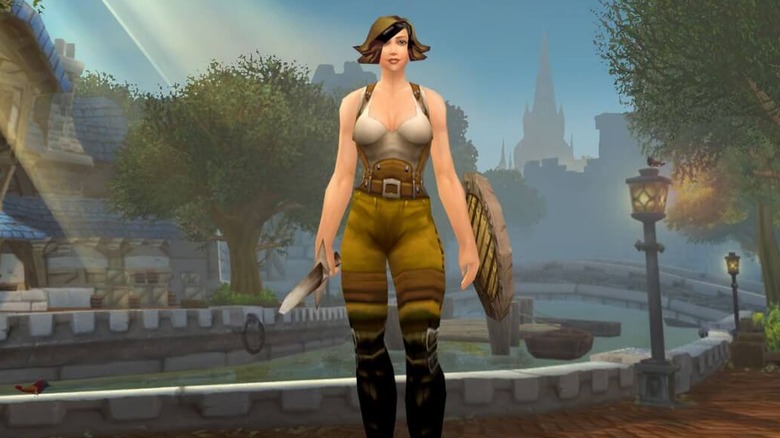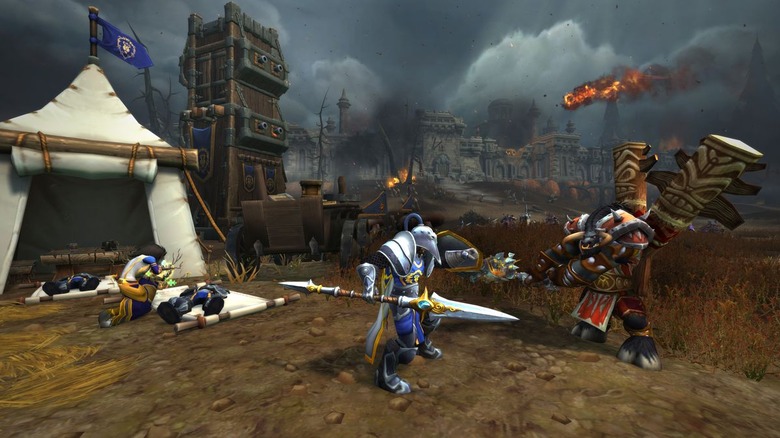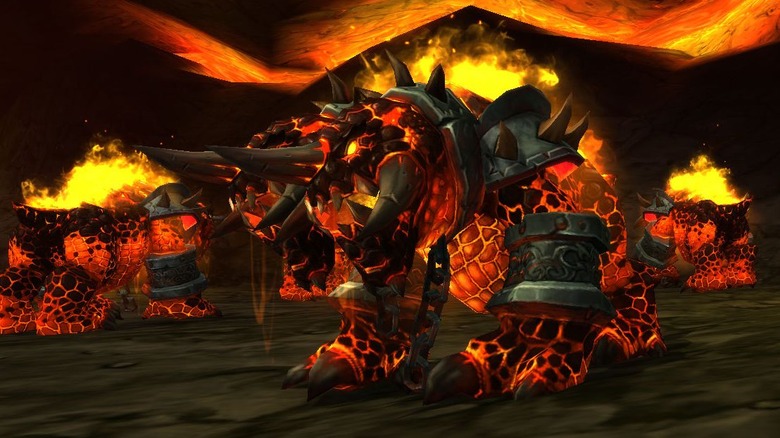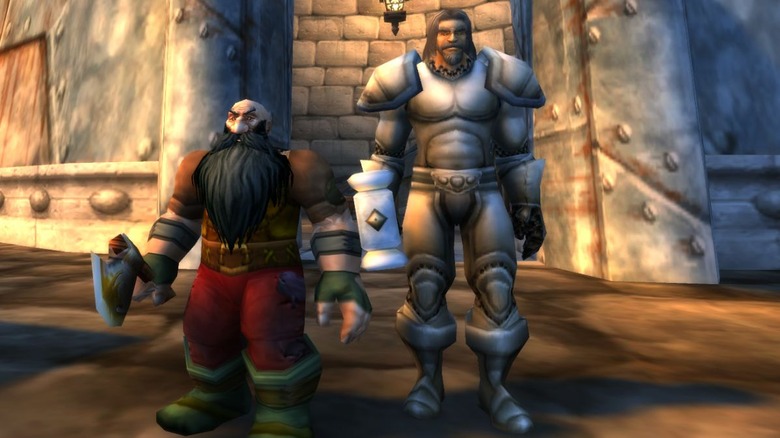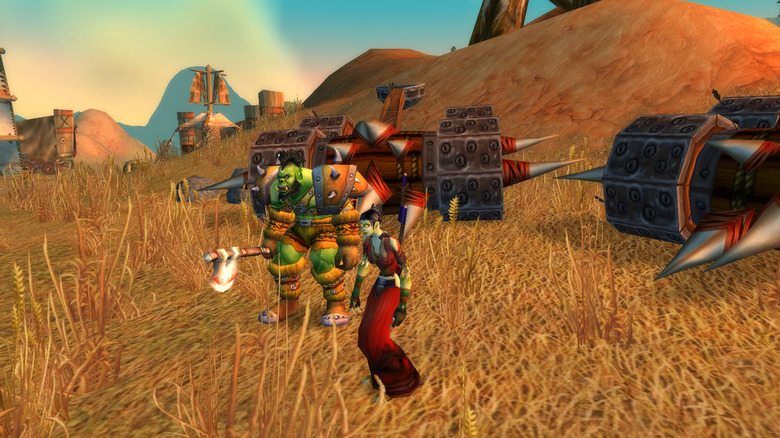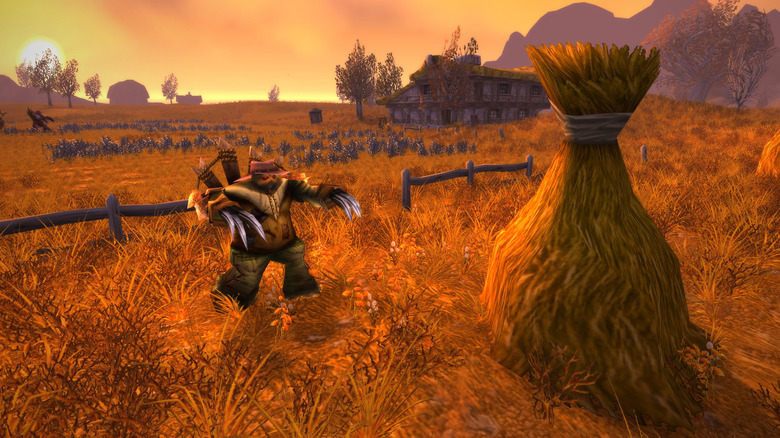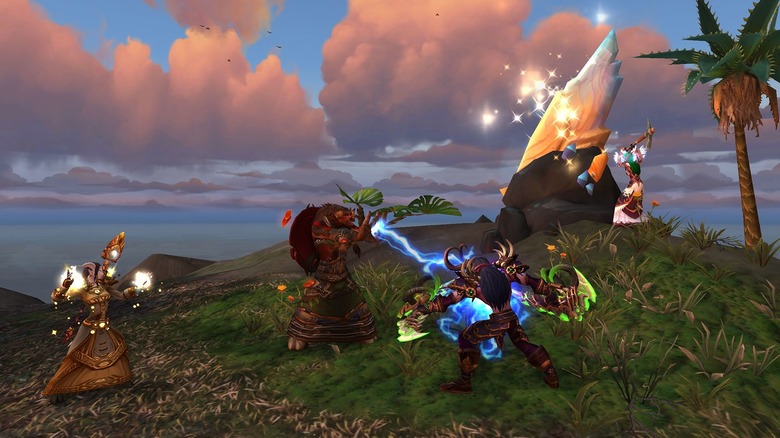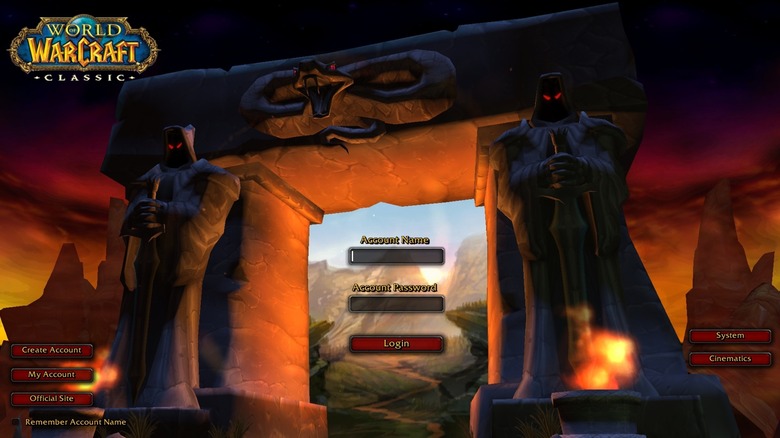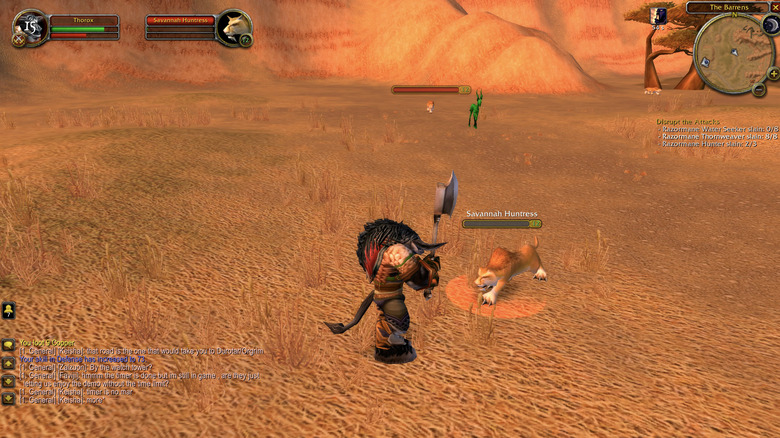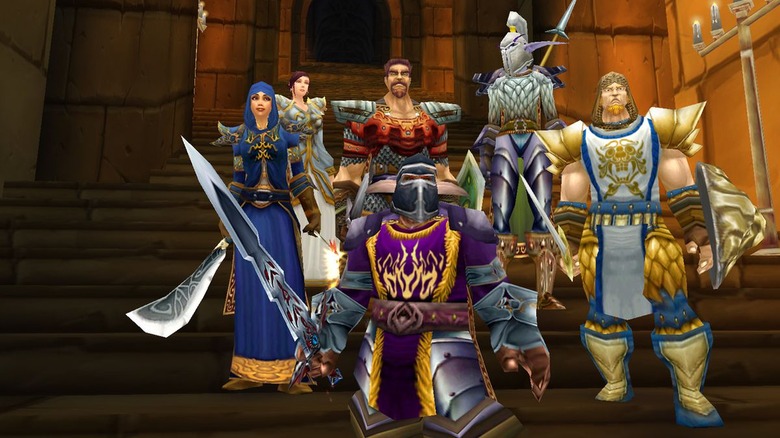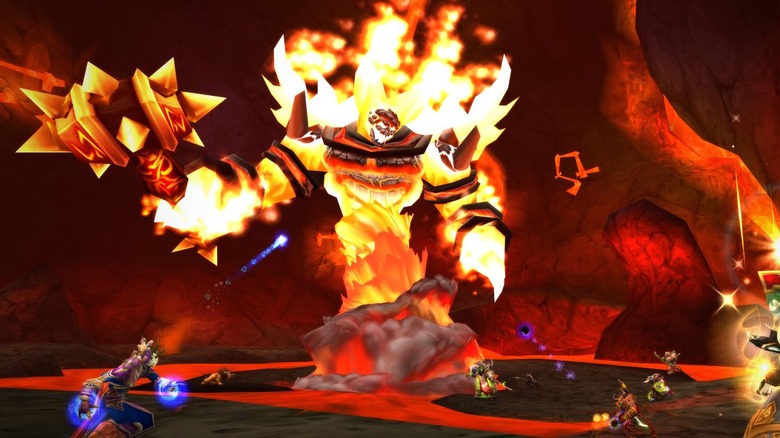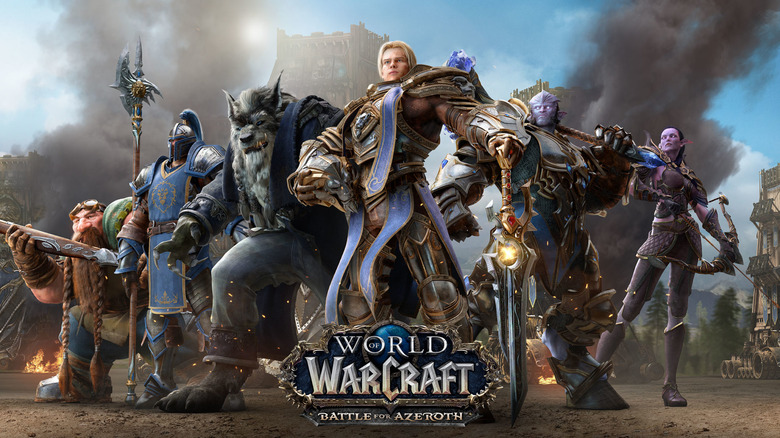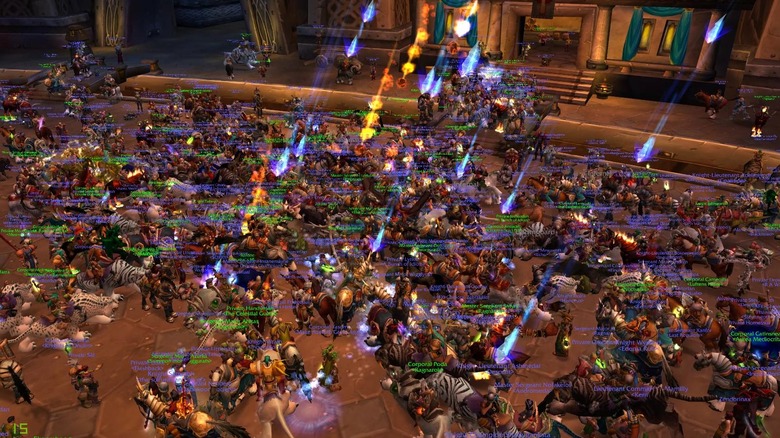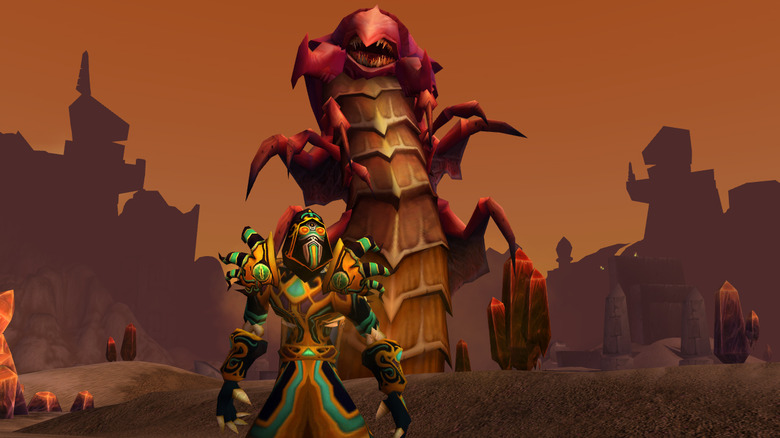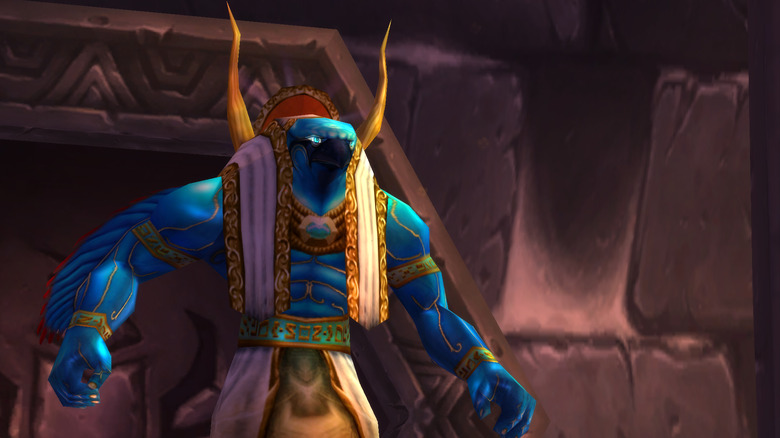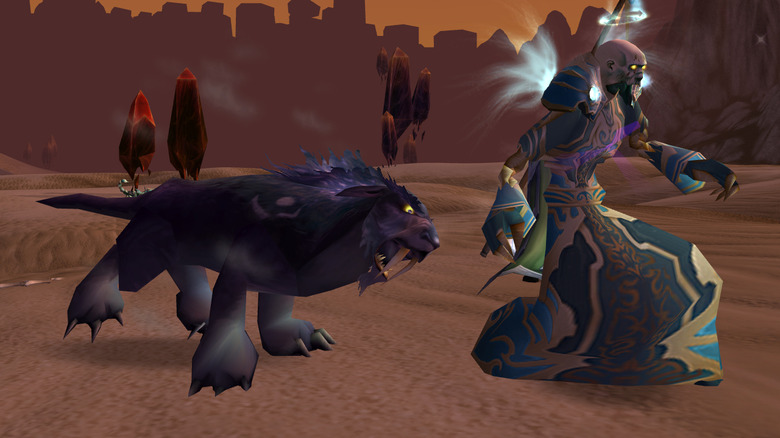Why We're Worried About World Of Warcraft Classic
World of Warcraft Classic is a game that fans have been patiently waiting for since Blizzard began modernizing their mammoth MMO. With every expansion and update, WoW slowly migrated away from many of the qualities its fans found endearing when the game launched for PC in 2004. The game is, without a doubt, much easier in its current form than it was when it first released, and some players genuinely miss the grind. Beyond that, the world of the game itself has also changed, leading many to long for the simplicity of some of the zones that were lost during the events of the Cataclysm expansion.
Not everything old is new again, though. World of Warcraft Classic is, for better or worse, a return to the 2006 era of the game that some feel was its peak. It's possible that nostalgia has colored that opinion significantly, though, because we've compiled an extensive list of issues the game might face. Here's our exhaustive set of reasons why we're worried about World of Warcraft Classic.
World of Warcraft Classic will split its own audience
World of Warcraft might be the biggest MMO of all time, but even its glorious reign at the top has some limitations. At its peak, WoW had about 12 million subscribers. While impressive, the game has only ever flirted with that number a couple of times after it first achieved it in 2010. More realistic (arguably even a little optimistic) interpretations of the active player base in recent years puts it anywhere between 1 and 4 million instead.
Let's get this out of the way first: yes, it's definitely true that some players have left World of Warcraft because it has become so radically different from what it once was. Those players are very likely interested in Classic, along with a number of active players who also miss the way things used to be.
With that said, though, there's hardly any evidence to suggest WoW has been pulling in new players recently. That means World of Warcraft Classic and World of Warcraft will be largely competing for the exact same audience: veteran players with specific ideas about how the game should look and feel. World of Warcraft Classic will essentially be asking its player base to choose which version of the MMO it wants. That could easily cannibalize players from the newest version, simply dividing up the amount of active players rather than increasing that figure in any way.
World of Warcraft Classic won't be able to keep things fresh
World of Warcraft has survived a long time. Obviously, a major factor in its longevity is Blizzard's ability to constantly release major updates and expansions. For one, it helps keep things fresh in a game that can only provide so much endgame content. It also means that one bad update doesn't spell the end of the world, as the next major content push can help swing things back in relatively short fashion.
The problem? Classic only has two years of content to play with. What will Blizzard do when players inevitably hit the endgame? An endgame, by the way, that they've already experienced and grinded through before.
World of Warcraft Classic is explicitly being designed to appeal to people who want none of the traditional draws of MMOs. The hardcore market for this title wants a preserved, 2006 version of World of Warcraft. It's going to be difficult to add new content, which will go against the core philosophy behind Classic. It might have to happen eventually, but it could cause players to leave. Given that the game's population will probably drop significantly after its first few months of novelty where off, that could be a big issue for those left playing.
World of Warcraft Classic is going to be ugly
World of Warcraft isn't the prettiest game by any means, but it's improved quite a lot over the years. Consistent tweaks to the game's graphics engine have made it at least somewhat pleasant to look at. That's become something of a necessity as competitors get released, since they're often far superior in terms of graphical prowess. WoW has done just enough to keep up, and people are generally satisfied with what's been done.
World of Warcraft Classic isn't using graphics that hold up to the test of time stylistically. Because development is starting with Patch 1.12 from 2006 and building up, the game will feature graphics from a similar point in time. That's going to be cute for a little bit, but that kind of attitude probably won't last. Poor graphics were a lot more forgivable when computer screens were a lot less powerful.
On high resolution screens, which many of the hardcore enthusiasts are likely to own, Classic is going to look, well, really bad. Fans will either need to run the game smaller or risk having some splotchy displays, and neither of those sounds like a particularly strong selling point for a game that's going to need to win people over in the long run.
Bad quest design will return
World of Warcraft Classic will represent something of a reset button for the game. That's good, in some ways. The game will return to a more simplistic representation of Azeroth, but it will also increase in difficulty, which should appease those who feel the current iteration is too easy. It will also be a reminder of how far the game has come, and will show off zones that have since changed with the release of Cataclysm.
Unfortunately, the game will also reset a lot of the work Blizzard has done to make the game more accessible. All of the updates and additions that have come over the game's long history after 2006 will be scrapped. World of Warcraft has been around for a long time, and that's a lot of quality-of-life changes that will get rolled back.
One of those changes will be to questing. World of Warcraft Classic will return us to the era in which nonsensical quest design tasked players with arduous cross-continent trips, only to ask them to double back to the original location to complete it. We can't imagine that's aged particularly well, and people might be shocked when they return to the game and realize that Blizzard learned quite a lot over World of Warcraft's lengthy lifespan.
World of Warcraft Classic will demand a lot of its players' time
The current iteration of World of Warcraft requires a lot of time to be sunk into it in order to reap the most appealing benefits. But there's also a lot at play in the endgame, and way more to do prior to getting there. Zones scale with players to a certain extent, making virtually everything accessible.
As a consequence of maintaining initial quest design and travel systems, World of Warcraft Classic will be an immense time sink. Not in the sense that players will have a lot to do, though. Just that it will take a lot of time to get to the things that need doing.
Many of the people who played early World of Warcraft are adults with responsibilities and families now. Even with the best intentions, that kind of schedule will result in extremely slow progress for them, enough that it could drive them away. When compared to other MMOs right now — including the current iteration of WoW — Classic is a daunting proposition for anyone without twelve hours a day to incinerate.
There's no reward for being a dedicated player
If splitting a demographic is a major concern, Blizzard has options. There are a bunch of different ways the company could integrate World of Warcraft Classic with its other offerings, especially World of Warcraft proper. That kind of synergistic approach could easily sway players into splitting their time between both offerings and maintaining healthy server populations.
Unfortunately, though, Blizzard has said that it wants to keep both the Classic and standard ecosystems completely separate, and that it plans to maintain that approach post-launch. That means players won't be able to transfer their characters to Classic. For those who might have been interested in getting started on endgame content right away with a max level character, they'll have to start leveling from scratch, which again speaks to the time considerations many adult players will need to deal with.
Furthermore, there won't be any sort of crossover that offers an incentive to get players to give Classic a try while maintaining their WoW subscription. While that subscription will get players free access to Classic on a monthly basis, attempting to blend the two could have been a major tipping point in getting Classic off the ground.
World of Warcraft's community is already split on sharding
One of the most controversial methods of server control ever implemented by Blizzard will at least be somewhat involved in World of Warcraft Classic. "Sharding" is a process that clumps players into smaller instanced groups so that servers can handle them. It was a key factor in Blizzard surviving some of the early days of World of Warcraft, when servers threatened to break under the game's swelling popularity.
The community largely hates sharding, though some are more than willing to tolerate it for a playable experience. The problem with sharding is that it can render players unable to play with their friends even if they're on the same server, which can be a frustrating experience, especially if it was organized for that specific time period.
Sharding is something that Blizzard is considering for Classic. It makes servers cheaper to maintain, for one thing, and it will lessen the strain on them when Classic launches. While sharding may not be used in all scenarios, its grim specter looms overhead, which could be problematic for some.
The same sense of discovery won't be there
World of Warcraft in its earliest iterations was something beautiful. It was a world teeming with possibilities, and it was new, the kind of game that really pushed the edges of how we understand game design. It didn't matter that quests took 30 minutes to hand in, or that a pack of wolves ten levels higher than your character were for some reason in the zone appropriate to your level. Everything was fresh and exciting.
A lot of the nostalgia that exists for World of Warcraft is rooted in the fact that it was an innovator when it launched. Now that gamers are intimately familiar with it, there won't be the same sense of discovery to buoy them through the extraordinarily long travel times that make up so much of the game. That could be problematic, especially when the usual fun of heading into a brand new zone is dulled by knowing every corner of it already.
Worse still, Blizzard can't really do anything about it. Like a lot of concerning factors in the development of Classic, the developer's hands are pretty well tied. Changing things to be new or to have a different layout would be antithetical to the concept of a preserved Vanilla WoW.
World of Warcraft got by on being the first of its kind
World of Warcraft didn't just give people a sense of wonderment thanks to its innovations, however. The game was absolutely at the forefront of pushing the MMO genre into uncharted territory. Popular with the masses rather than one of the most niche demographics in gaming, WoW was the first game that really felt "massive" in the way that was imagined by its label.
To put it bluntly, though, WoW's early form had a ton of issues that it got a pass on for being revolutionary during its release. World of Warcraft Classic will return to that setup but with over a decade's worth of game design evolution having passed it by. Returning to a game that is riddled with a lot of questionable choices could be disastrous. Getting people who already subscribe to play the newest form of World of Warcraft is one thing, but getting someone who isn't paying monthly to do so for a known, deeply flawed title is another.
Raids are going to be difficult to get together
Raids were one of the most appealing elements of World of Warcraft in its early days. The scale of them was, once again, something that players just hadn't gotten to experience before, especially with the level of detail Blizzard paid to each instance. Players with gear from the largest and most difficult raids were legends on their servers, and the fights were extremely difficult.
Nowadays, raiding is easier than it has ever been thanks to improvements in the UI and streamlined approaches. But World of Warcraft Classic will return to a time when players had to coordinate 40 players on their own to gather them all in the right place.
That was difficult back in 2006 for all but the top guilds on each server. It's going to be exceptionally difficult to find people with the time now, and it seems as though more people will be locked out from seeing Naxxramas in all of its classic glory now than they ever were before. Again, this kind of issue may not present itself immediately after launch, when everyone has set aside a ton of time to play. Still, expect it to become a major problem sooner rather than later.
Faction balance might be an issue
Back in the day, choosing a faction in World of Warcraft was the kind of thing that could genuinely splinter friend groups. Once a player chose a faction, they were locked in on their server. Furthermore, Horde and Alliance players could only interact by fighting each other, which typically meant friends would have to unanimously decide on which faction they wanted to play as and represent.
That was fun, but Patch 1.12, which World of Warcraft Classic will follow, was not a perfect game when it came to faction balance. PvP could be a big issue based on a server's composition: if the Horde was the strongest faction on that server, more players would roll Horde characters, compounding the problem. It would make it difficult to queue as Alliance and could inflate wait times for PvP content.
Having the emphasis on factions reappear will be a bonus for many players who access Classic. Unfortunately, though, the game doesn't seem well prepared to address previous issues of server balancing, and we could see the same ugly problems rear their head as the best PvP players establish themselves in the game's early months.
Class balance might be an even bigger issue
World of Warcraft Classic will also retain the class balancing from Patch 1.12, which was probably the closest vanilla WoW ever got to achieving a healthy state. As of 2006, Blizzard had about two years' worth of data to parse through regarding class performance, and some meaningful adjustments had been made to ensure that every class had a role in the endgame.
That doesn't mean it was actually balanced, though. Retribution Paladins were laughed out of the room, and classes like Priest were really only viable in healing roles most of the time. Shamans also routinely struggled to find their place in this era of World of Warcraft. It was just the beginning of a long process to get many of the classes into fighting shape.
Another thing that might be difficult to swallow regarding class balance is that future patches have clearly acknowledged what was wrong with each class. There's testimony that spans years that shows classes still needed work. With the knowledge that things could be better, will Classic's class balancing really be so easy to slip back into? We have our doubts.
What happens after Blizzard fulfills the roadmap?
It's certainly nice to know that, if you make the effort to grind in World of Warcraft Classic, Blizzard will treat you to a guaranteed plethora of content. Back in March 2019, Blizzard laid out a six-phase roadmap featuring a multitude of PvE content as well as some PvP. Upon launch, the game will include content from the original 1.2 patch, with the next designated rollout featuring events from the 1.3 and 1.4 patches. When all's said and done, dedicated players will have experienced everything from the Molten Core raid to the Scourge Invasion.
Here's the question, though: what happens after Blizzard fulfills that roadmap? While we don't know exactly when the devs will release each update, they likely won't dawdle too long, especially considering the core of all this content has been part of the game's history for over a decade. Will Blizzard announce another multi-phase roadmap as players near the end of this first one? Or will this simply be a small chunk of a game, acting as nothing more than a nostalgia trip? Time will tell.
Who knows if Ahn'Qiraj will actually work this time
During phase five of the Classic roadmap, Blizzard will include the infamous Ahn'Qiraj War Effort and its subsequent raids. For those unfamiliar, this was one of the game's earliest attempts at a server-wide world-changing event. Unique to the game at the time, players had to trigger this event, which would happen solely based on dedication and participation. Basically, a server filled with persistent players could unlock the Gates of Ahn'Qiraj much faster than a server filled with casual players. Unfortunately, crashes, bugs, and instability plagued the ambitious content. Things got so bad that, to this day, Blizzard hasn't attempted another event of this magnitude.
Now, the dev team's opening up old wounds and including this content in Classic. So, of course, the natural question to ask is, "Will it actually work this time?" It's not an unfair query. Surely, there are players itching to take a shot at Ahn'Qiraj, possibly looking for a better experience than they had in 2006. If it fails this time, that's a very bad look for Blizzard and World of Warcraft.
You better love walking
If you've played World of Warcraft for its 15-plus years, you likely remember the days when the game featured much slower progression, tougher exploration, and a generally higher difficulty when it came to "the grind." WoW has changed with the times, becoming a faster-paced game that some purists might argue has lost its way. Outside of quest and objective markers as well as simpler PvE combat, one of the biggest things that current WoW offers is easier access to mounts. During certain events and times of the year, you can easily obtain mounts via subscriptions and other content drops. In fact, Blizzard offered a brand-new mount if you purchased a six-month sub during June 2019!
But, rewind back to the first days of World of Warcraft and world traversal wasn't nearly that simple. Until you hit level 40 and received your first mount, you were walking all over the place. This made the grind so much longer, and that's what you'll experience during Classic's rollout. Get used to your character's walk animation, because you'll see it non-stop for a long while. How that will resonate with players remains to be seen, but expect to see plenty of forum posts filled with complaints about the slower pace leading up to that 40th level.

